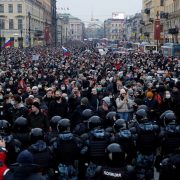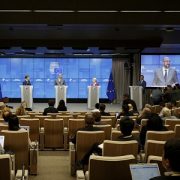
The country’s future, the CPC, and democracy are at stake in Beijing’s drive for reunification with Taiwan. Now more than ever, sweeping them under the carpet won’t be easy.
In what state is the Chinese state? For centuries, China was not a state like its European counterparts. England, Spain, France, or Germany and the Holy Roman Empire transitioned seamlessly from one dynasty to another, sometimes with powerful ruling families moving from one country to another—for example, the Habsburgs from Germany to Spain, the Bourbons from France to Spain, the Oranges from Holland to England, or the Hohenzollerns who famously occupied many European thrones in the late 19th century.
China, however, was different. It was characterized by a succession of distinct ruling dynasties, each with its own characteristics. The People’s Republic of China (PRC) is somehow different yet still like all other dynasties. Like its predecessor, the Manchu Qing state, which revolved around the tightly controlled organization of the eight banners and their bannermen; the PRC operates according to party (CPC) rules and a hierarchy of “nobility” based on when a family joined the revolution and the rank they held.
Unlike the imperial past, the top leader, similar to an emperor, doesn’t need to be a direct descendant of the previous ruler. No son of Mao Zedong or Deng Xiaoping came close to the highest rank. In its latest form, under President Xi Jinping, the choice of the ruler is exercised by the party itself, which self-regulates, produces the supreme leader, and adapts to the leader’s wishes. The leader and the party mechanism exist in a symbiotic relationship—the party can’t survive without its leader, and the leader can’t maintain power without the party. This configuration resembles the self-sustaining state imagined by philosopher Hanfeizi in the late 3rd century BC. His theory helped establish China’s first unified empire and inspired a 2000-year-old imperial system aiming to maximize state power and efficiency. Yet perhaps never before has it taken such a tangible form, and now, the national situation is somehow extraordinary.
Here is a small step back. During the Cultural Revolution (1966-76), Mao sought to dismantle de facto a party he couldn’t control or didn’t have the patience to manage, as it was managed primarily by his main rival at the time, Liu Shaoqi. In contrast, Xi seeks to control and harness the party’s power. An internal conflict arose because Xi wanted to use the party for his goals. In contrast, party officials (especially after Mao’s and Deng’s disruption) have “privatized” party structures, creating their own large or small fiefdoms, and now resist falling in line with Xi.
How do we reconcile the two? Party members can’t wield power without the party or Xi, and Xi can’t command the party without its members. Education is the key: molding and remolding party members.
However, there are new challenges: while younger members might be more pliable, they occupy lower rungs on the party ladder and are often inhibited by their disillusioned superiors. Encouraging their rebellion (à la Mao) could disrupt the entire party without specific results. Then, the necessary path becomes re-educating the higher ranks, which yields more grumbling and passive resistance while the young become disenchanted.
These are many contradictions. Yet some in China argue that ‘the Chinese have a history of mass education. Plus, isn’t the West full of contradictions, too? Yet we manage ours.’
Perhaps the twist is that Western contradictions tend to resolve themselves (due to specific political and social structures) with minimal state intervention and entropy; Chinese contradictions need incessant party intervention, creating growing entropy. It’s also true that China is more accustomed to entropy and may sustain itself longer than Western states.
The catch is that 50 years of party disruption created a break, making it much harder to return to “fully educated” party members. It would have been easier to pursue full liberalization and democratization to dispel the “fiefdoms,” but there’s a pragmatic one beyond ideological preference: party leaders didn’t know how to manage democratization; it isn’t in their history or education. In the past decades, the democratic West seemed to believe democracy was natural, yet it needs substantial nurturing. Moreover, foreign democratic “education” was seen as an external push for political change, which China’s ruling elite firmly opposed.
Taiwan
The challenge of democracy still exists in Beijing. It was suppressed in Hong Kong but remains firm in Taiwan, the de facto independent island that Beijing wants to reunify. The primary stumbling block is the difference in political systems between Beijing and Taipei, especially after Hong Kong’s freedom was crushed and its democratic aspirations forfeited. Many in Taiwan and beyond believe that a reunified Taiwan would be no different because Taiwan’s vibrant democracy could be a virus spreading, potentially overturning the party.
Over the weekend, Wang Huning, number four in the party hierarchy, met Taiwan’s ex-president Ma Ying-jeou. This was reportedly interpreted[1] as a new job for Wang—to reunify the island. Wang has served all party leaders since the late 1980s, starting with Zhao Ziyang, Jiang Zemin, Hu Jintao, and now Xi. If he successfully progresses with Taiwan, it will be a party triumph; if he fails, by 2027, when Wang is due to retire, the party will have failed, not just Xi. Then, the party could decide on Taiwan’s future differently.
Moreover, Wang is an ideology guy, so the ideological clash between the PRC system and island democracy will have to solve Taiwan peacefully without military intervention.
These are prima facie deductions. Then there are suppositions. Xi must find a way out of his current bind on Taiwan and convey peace to calm businesses, and the economy flustered over the mounting saber-rattling about the island.
Wang’s initiative doesn’t rule out regaining Taiwan through force but may introduce different options and postpones the issue for a few years, waiting to see what unfolds in Russia and the Middle East. After Hong Kong’s experience, few believe Taiwan’s democracy could survive reunification with the PRC. However, Wang’s move may raise bigger questions about China’s future political direction: how to reconcile party structure with democracy? Should Taiwan’s democracy be peacefully abolished or modified? After all, the forces impatient with democracy have grown stronger in many Western countries, so what if China discards it? Conversely, will party structures be amended or reformed to adapt to Taiwan’s freedom? Then, what’s the future of democracy if Asia, the largest continent, grows tired of it?
These questions have been an underground river in party discussions for decades, surfacing sometimes and then getting buried some more underground. They are not about who rules the country or the party structure but about what China is or should be and what level of entropy the country can withstand in the following yearswithout straining the seams of the system too much. This is particularly true with two open wars and mounting international tensions. Democratization can be risky for the CPC, but stress on multiple fronts won’t be a walk in the park either.
- A cooperation with Appia Institute.
[1] See https://www.nytimes.com/2024/10/26/world/asia/china-xi-jinping-adviser-taiwan.html?ogrp=dpl&unlocked_article_code=1.VE4.XRWJ.zQGHyU5FiIUW&smid=url-share





